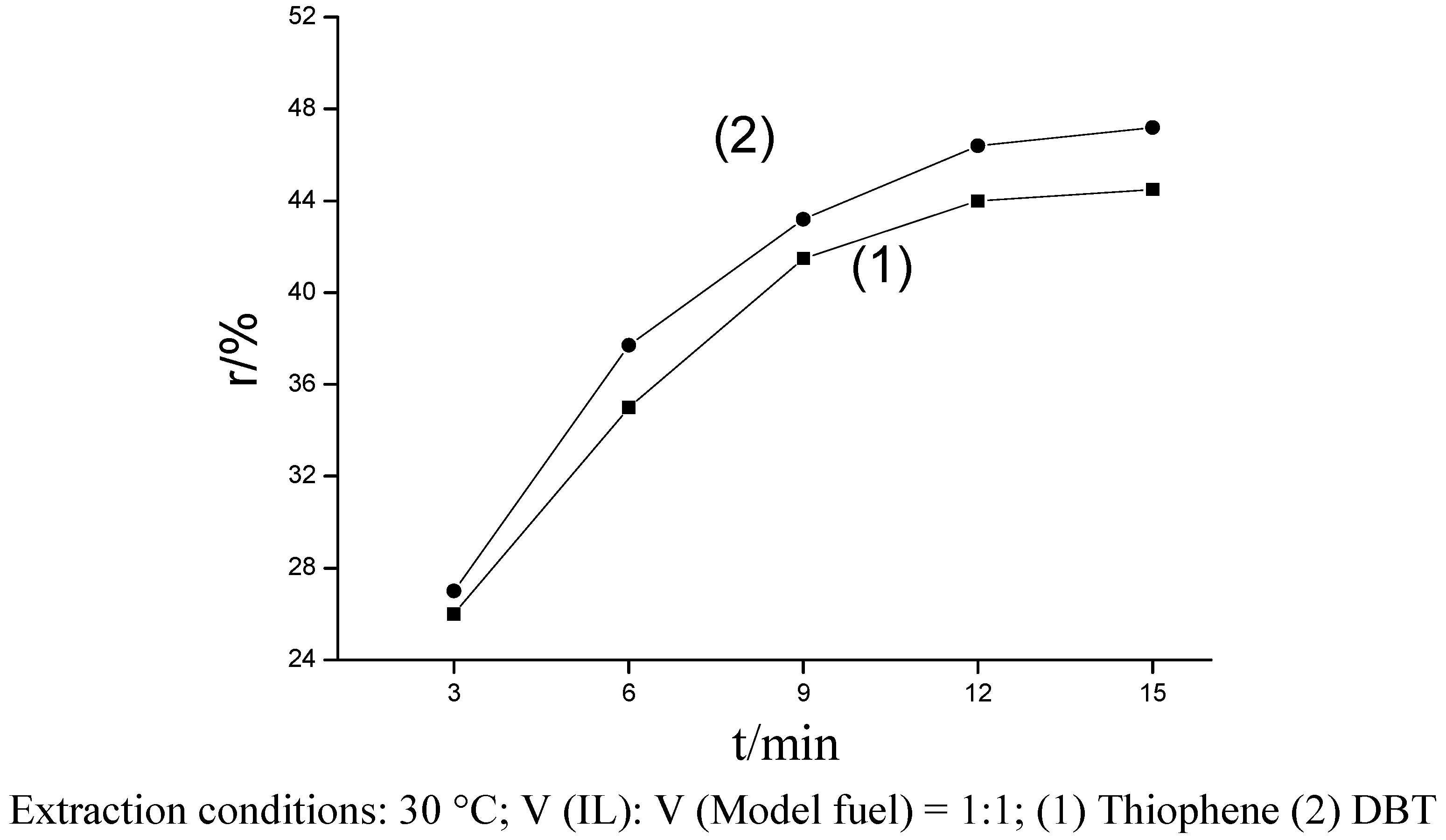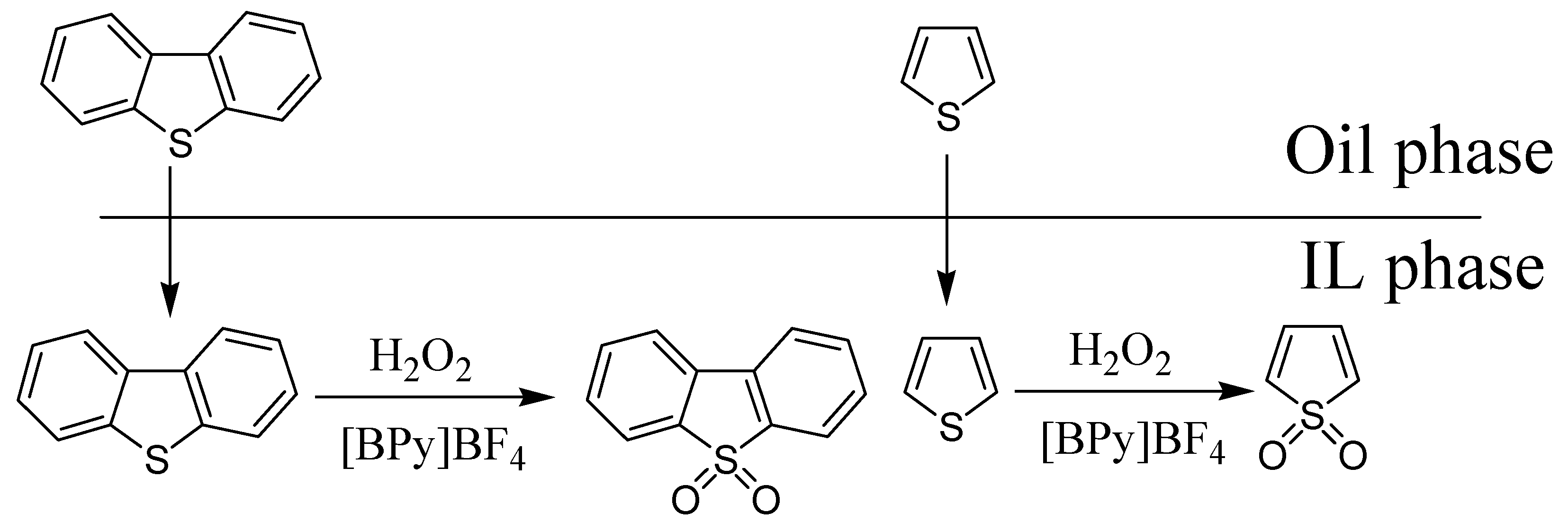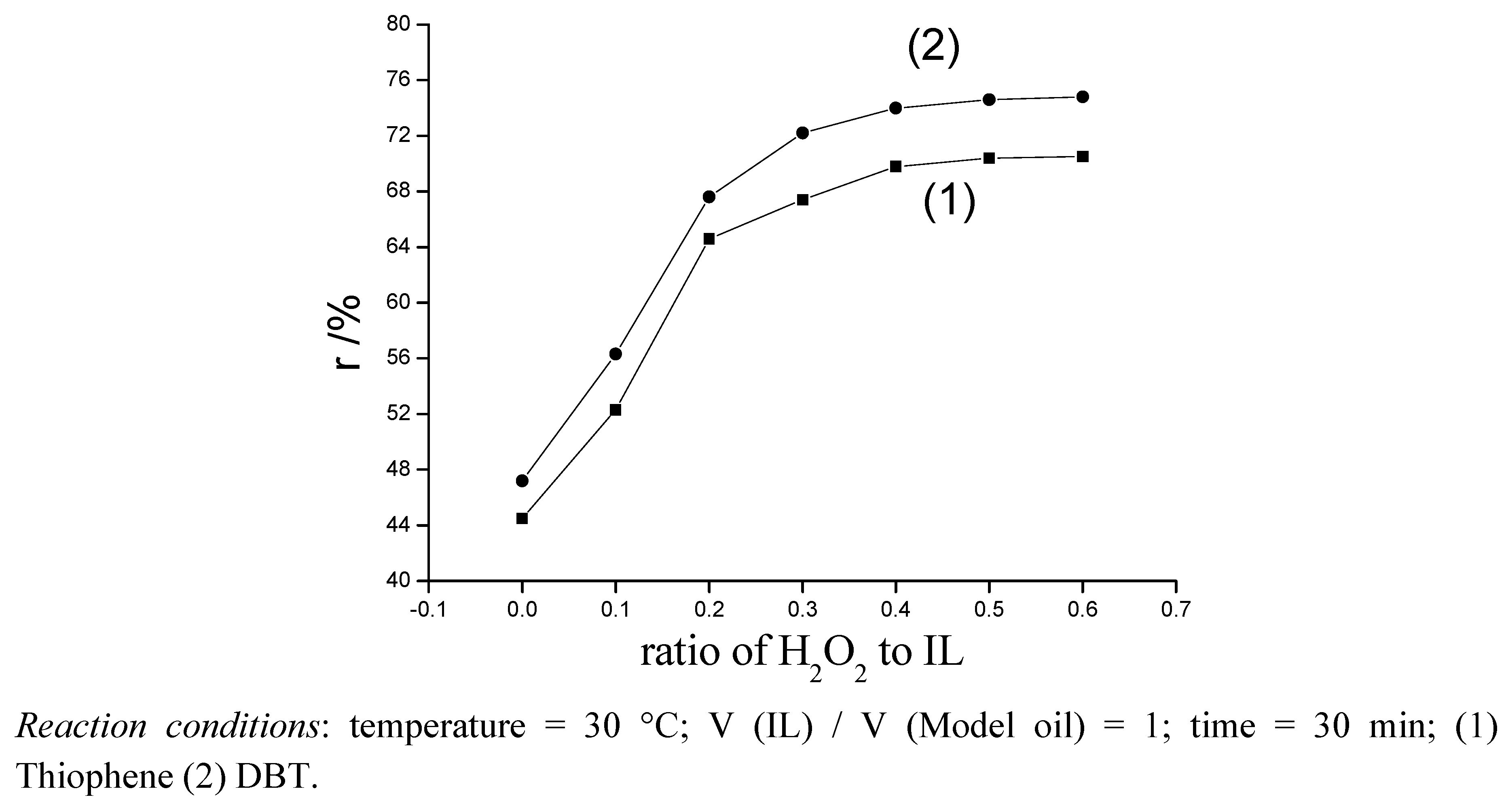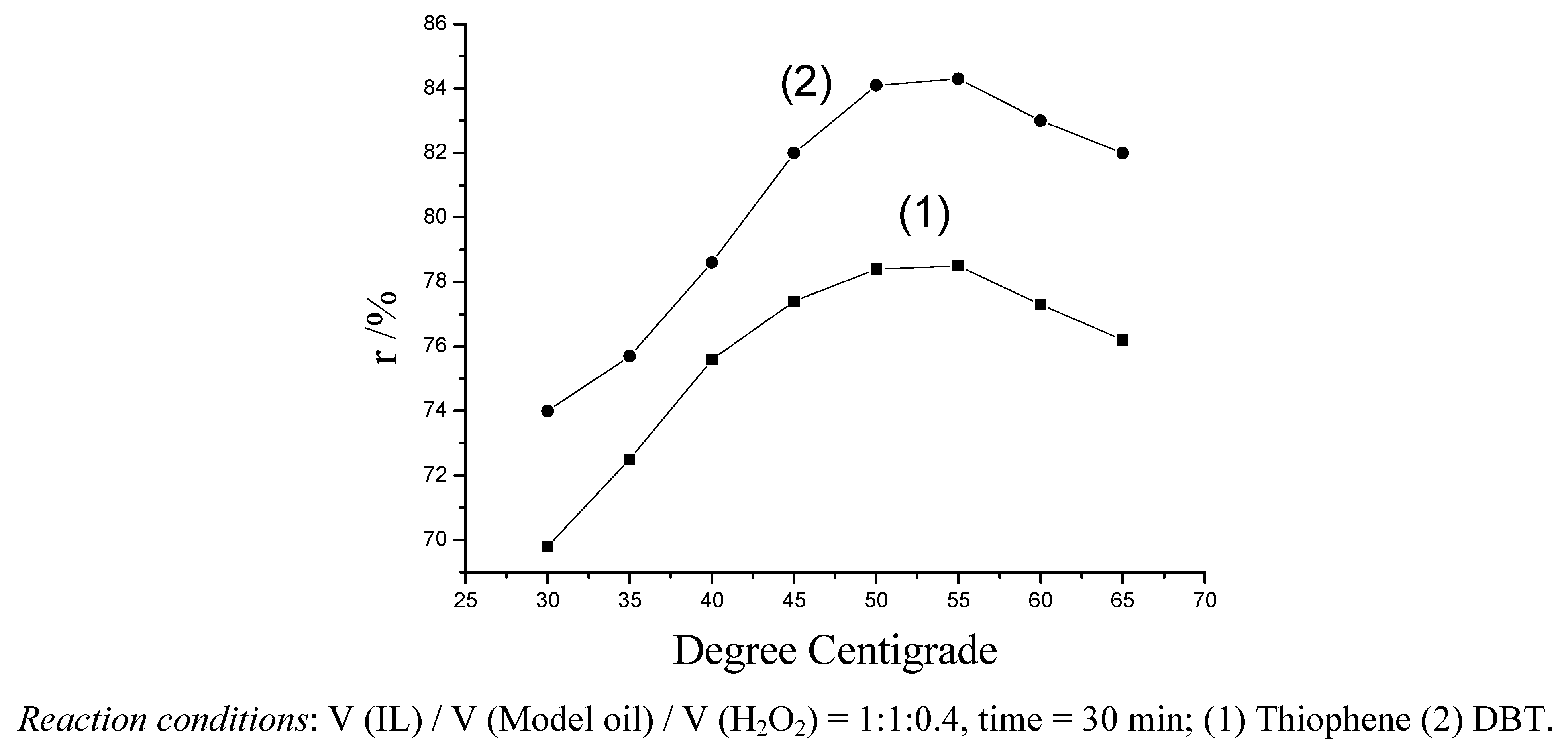Oxidative Desulfurization of Fuel Oil by Pyridinium-Based Ionic Liquids
Abstract
:1. Introduction
2. Results and Discussion
2.1. Effect of extractive desulfurization for model oil

2.2. Effects of oxidative desulfurization for model oil

2.2.1. Effect of the amount of H2O2 on desulfurization of model oil

2.2.2. Effect of temperature on desulfurization of model oil

2.3. Oxidative desulfurization of gasoline with IL
| IL system | Primal sulfur content | Desulfurization |
|---|---|---|
| Extractiona | 780μg/mL | 35.9% |
| Extraction-oxidationb | 780μg/mL | 56.3% |
2.4. Regeneration of used IL
| Regenerated time | Thiophene | DBT |
|---|---|---|
| Fresh IL | 78.5% | 84.3% |
| 1 | 77.0% | 83.2% |
| 2 | 76.4% | 82.0% |
| 3 | 75.8% | 81.1% |
| 4 | 74.3% | 80.3% |
| 5 | 72.1% | 77.5% |
3. Experimental
4. Conclusions
Acknowledgements
- Sample Availability: Samples of the compounds IL([BPy]BF4) and gasoline are available from the authors.
References and Notes
- Shafi, R.; Hutchings, G.J. Hydrodesulfurization of hindered dibenzothiophenes: An overview. Catal. Today 2000, 59, 423–442. [Google Scholar]
- Song, C.S. An overview of new approaches to deep desulfurization for ultra-clean gasoline, diesel fuel and jet fuel. Catal. Today 2003, 86, 211–263. [Google Scholar]
- Ko, N.H.; Lee, J.S.; Huh, E.S.; Lee, H.; Jung, K.D.; Kim, H.S.; Cheong, M. Extractive desulfurization using fe-containing ionic liquids. Energ. Fuel. 2008, 22, 1687–1690. [Google Scholar] [CrossRef]
- Hernandez-Maldonado, A.J.; Stamatis, S.D.; Yang, R.T. New sorbents for dusulfurization of diesel fuels via complexation: Layered beds and regeneration. Ind. Eng. Chem. Res. 2004, 43, 769–776. [Google Scholar] [CrossRef]
- Li, W.; Wang, M.D.; Chen, H.; Chen, J.M.; Shi, Y. Biodusulfurization of dibenzothiophene by growing cells of gordonia sp. in batch cultures. Biotechnol. Lett. 2006, 28, 1175–1179. [Google Scholar] [CrossRef]
- Li, W.L.; Tang, H.; Liu, Q.H.; Xing, J.m.; Li, Q.; Wang, D.; Yang, M.H.; Liu, H.Z. Deep desulfurization of diesel by integrating adsorption and microbial method. Biochem. Eng. J. 2009, 44, 297–301. [Google Scholar] [CrossRef]
- Bösmann, A.; Datsevich, L.; Jess, A.; Lauter, A.; Schmitz, C.; Wasserscheid, P. Deep desulfurization of diesel fuel by extraction with ionic liquids. Chem. Commun. 2001, 2494–2495. [Google Scholar]
- Lo, W.H.; Yang, H.Y.; Wei, G.T. One-pot desulfurization of light oils by chemical oxidation and solvent extraction with room temperature ionic liquids. Green Chem. 2003, 5, 639–642. [Google Scholar] [CrossRef]
- Huang, C.P.; Chen, B.H.; Zhang, J.; Liu, Z.C.; Li, Y.X. Desulfurization of Gasoline by Extraction with New Ionic Liquids. Energ. Fuel. 2004, 18, 1862–1864. [Google Scholar] [CrossRef]
- Zhang, S.G.; Zhang, C.Z. Novel properties of ionic liquids in selective sulfur removal from fuels at room temperature. Green Chem. 2002, 4, 376–379. [Google Scholar] [CrossRef]
- Zhang, S.G.; Zhang, Q.L.; Zhang, C.Z. Extractive desulfurization and denitrogenation of fuels using ionic liquids. Ind. Eng. Chem. Res. 2004, 43, 614–622. [Google Scholar] [CrossRef]
- Nie, Y.; Li, C.X.; Wang, Z.H. Extractive Desulfurization of fuel oil using alkylimidazole and its mixture with dialkylphosphate ionic liquids. Ind. Eng. Chem. Res. 2007, 46, 5108–5112. [Google Scholar] [CrossRef]
- Nie, Y.; Li, C.X.; Sun, A.J.; Meng, H.; Wang, Z.H. Extractive desulfurization of gasoline using imidazolium-based phosphoric ionic liquids. Energ. Fuel. 2006, 20, 2083–2087. [Google Scholar] [CrossRef]
- Zhao, D.S.; Wang, J.L.; Zhou, E.P. Oxidative desulfurization of diesel fuel using a Brønsted acid room temperature ionic liquid in the presence of H2O2. Green Chem. 2007, 9, 1219–1222. [Google Scholar] [CrossRef]
- Su, B.M.; Zhang, S.G.; Zhang, Z.C. Structural elucidation of thiophene interaction with ionic liquids by multinuclear NMR spectroscopy. J. Phys. Chem. B 2004, 108, 19510–19517. [Google Scholar] [CrossRef]
- Wang, J.L.; Zhao, D.S.; Zhou, E.P.; Dong, Z. Desulfurization of gasoline by extraction with N-alkyl-pyridinium-based ionic liquids. J. Fuel Chem. Technol. 2007, 35, 293–296. [Google Scholar] [CrossRef]
© 2009 by the authors; licensee Molecular Diversity Preservation International, Basel, Switzerland. This article is an open access article distributed under the terms and conditions of the Creative Commons Attribution license ( http://creativecommons.org/licenses/by/3.0/).
Share and Cite
Zhao, D.; Wang, Y.; Duan, E. Oxidative Desulfurization of Fuel Oil by Pyridinium-Based Ionic Liquids. Molecules 2009, 14, 4351-4357. https://doi.org/10.3390/molecules14114351
Zhao D, Wang Y, Duan E. Oxidative Desulfurization of Fuel Oil by Pyridinium-Based Ionic Liquids. Molecules. 2009; 14(11):4351-4357. https://doi.org/10.3390/molecules14114351
Chicago/Turabian StyleZhao, Dishun, Yanan Wang, and Erhong Duan. 2009. "Oxidative Desulfurization of Fuel Oil by Pyridinium-Based Ionic Liquids" Molecules 14, no. 11: 4351-4357. https://doi.org/10.3390/molecules14114351
APA StyleZhao, D., Wang, Y., & Duan, E. (2009). Oxidative Desulfurization of Fuel Oil by Pyridinium-Based Ionic Liquids. Molecules, 14(11), 4351-4357. https://doi.org/10.3390/molecules14114351





